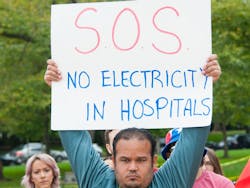After two years of debate and planning, Puerto Rico finally appears positioned to re-create its electric grid with microgrids and renewable energy, mandated in a new utility integrated resource plan (IRP).
California-based BoxPower is among several private companies supplying microgrids in Puerto Rico. Photo courtesy of BoxPower
The mandate came from the Puerto Rico Energy Bureau, the island’s chief energy regulator, in late August. Utility IRPs are guiding documents produced by US utilities to determine the least-cost way to manage gaps between existing resources and future needs. PREPA has been working on this version of its IRP since March 2018.
Microgrids became a big part of island reconstruction after its entire grid failed from the onslaught of Hurricane Maria in September 2017. But much of the microgrid development has been piecemeal, done by private, federal or non-profit sources to help schools, hospitals, businesses and remote communities.
Now, however, the bureau has ruled that microgrids must be a central part of the grid planning by the island’s utility, the Puerto Rico Electric Power Authority’s (PREPA).
The bureau ordered PREPA to “directly incorporate promotion of microgrid resources into all of its transmission, distribution, and resource planning,” noting that microgrids “form a critical part of the resiliency solutions envisioned” for Puerto Rico.
Renewables central to IRP
The regulators added that the mandate “includes facilitating timely and non-discriminatory access for all DG (distributed generation) and microgrid facilities to interconnect with PREPA’s grid.”
The order also gives renewable energy a central role and requires that the utility equally weigh a range of renewable technologies. The utility will seek power purchase and operating agreements through competitive requests for proposals (RFPs).
“They’re seeking aggressive RFPs for renewable penetration and they’re agnostic as to which technology,” said Agustín Carbó, senior manager for microgrids at the Environmental Defense Fund, which participated in the proceeding. “There are different options for renewables that need to be considered on equal footing, such as a hydro, solar-plus-storage, wind, off-shore wind. So there is a variety in the mix.”
The competitive solicitations are meant to help the island meet a government goal of 40% renewables by 2025 and 100% by 2050. Renewables now make up only about 2% of its electric supply.
The bureau also requires that the utility issue solicitations for battery energy storage to help integrate renewables and meet peak load requirements. Scenario models indicate Puerto Rico will need to seek somewhere between 2,580-5,200 MW of solar photovoltaics by 2025 and 1,360-1,720 MW of battery energy storage.
PREPA will conduct the auctions with oversight from the bureau. The utility has 60 days to produce a plan for the solicitations.
It’s unclear how robust the bidding will be in light of PREPA’s bankruptcy status and the overall unsteadiness of the COVID-19 economy.
Incentivizing bidders
“It’s a tough market with a tough economy. With everything that’s happening in the world, it definitely could be a challenge. But we’ll see,” said Carbó.
Given the economic challenges, the bureau instructed PREPA to take action to incentivize bidders to offer lower prices, such as finding ways to minimize counterparty risk. This could include staging the RFP processes to avoid locking in higher prices early, if later-stage RFPs are likely to bring in lower bid prices.
PREPA must evaluate the bids based on at least the following criteria:
- Cost for energy and capacity
- Recognition of T&D losses
- Resilience benefits
- Timeline
- Technical superiority of location for interconnection
- Nearness to load
- Locational diversity around the island in proportion to load
Yes to VPPs in Puerto Rico
Aggregations and virtual power plants are “explicitly allowed” to bid, under the order.
In fact, virtual power plants and aggregations come out as winner in the plan
For example, distributed energy resources will be able to compete head to head with utility scale resources for PPOAs, the bureau said, noting that it agrees with Sunrun and others that VPPs can offer capacity to the grid in the form of solar plus storage.
The order also calls for the utility to create internal systems as well as external programs, offerings, or solicitations to engage demand response aggregators in ways that serve all customer classes.
EDF had pushed for VPPs and aggregations in the plan, expressing concern that despite the growth in customer-sited solar and batteries, PREPA does not offer any incentives or a procurement process for VPPs.
No to minigrid plan
In an earlier draft of its IRP, PREPA had proposed dividing the island into eight minigrids, but the bureau rejected the $5.9 billion plan. In North America, a minigrid is defined as a large and complex microgrid, in this case cited to support clusters of critical transmission and distribution voltage loads, downstream of distribution and transmission vulnerabilities.
The utility did not make the case that minigrids are less expensive than alternatives; nor did it fully incorporate microgrids and other distributed resilience measures into the minigrids, the bureau said.
However, the bureau still wants to explore the concept and plans to open a minigrid proceeding in the fall. The bureau is considering one or two minigrid test sites, particularly the San Juan/Bayamon region because of the region’s load density.
The 332 page IRP decision also covers a wide range of other planning issues for the utility, among them new, upgraded and retiring generation, grid hardening, LNG infrastructure, peaking resources, energy efficiency and demand response.
The bureau decision can be found here.
Track news about micorgrids in Puerto Rico. Subscribe to the free Microgrid Knowledge newsletter.







